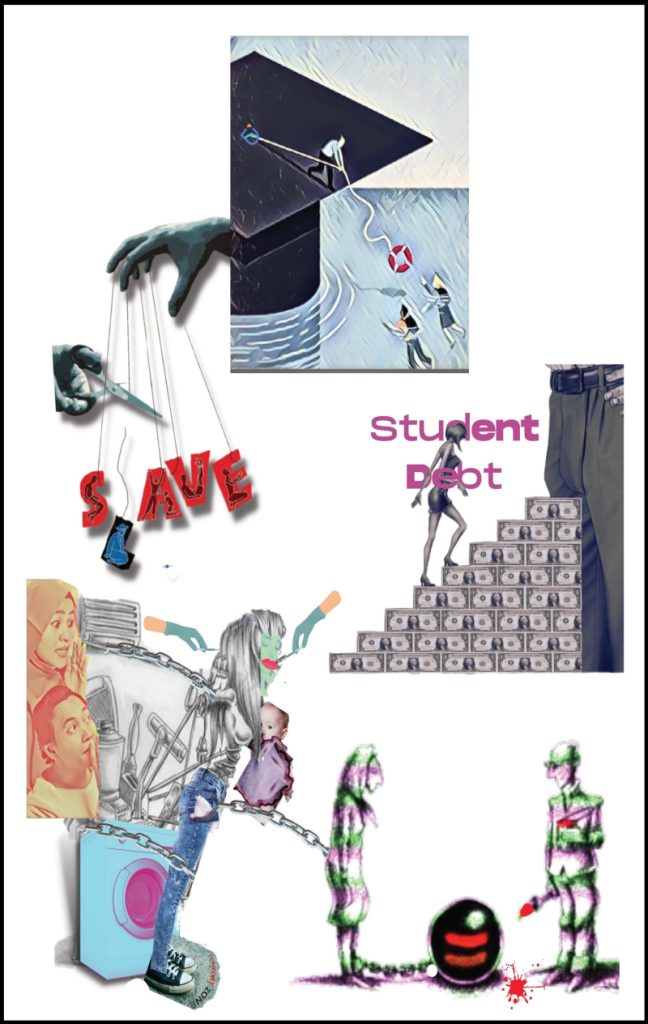6 Gendered Ageism

By Katherine Hall
This collage represents gendered ageism (World Health Organization, 2021). Having experienced the demands of raising a family, postponing education, cultural expectations, and low-income stereotypical female employment resulted in experiencing gendered ageism. I advocate that gendered ageism in university is a social justice issue. Personally, gendered ageism became apparent in the recruitment process from universities’ advertisements and the lack of scholarships or grants for older students.
UNESCO advocates that global poverty would be reduced in half by completing secondary education (Kotasinska & Watkins, 2020). Barriers to access higher education are summarized in the 1982 quote from Audre Lorde: “There is no such thing as a single-issue struggle because we do not live single-issue lives” (as cited in Dorfman, 2012, para. 12). Women are less likely to have pensions or significant retirement savings since they have often made less money and spent fewer years working (World Health Organization, 2021). The reasons older women pursue higher education vary but ultimately, it increases their earning potential. Educational institutions commonly lack a framework to support gendered ageism due to an unconscious outgroup bias (Rodrigues, 2022; Sorella, 2022).
Fostering a community for older students (PBS NewsHour, 2021), full support for evening and weekend classes, teacher candidates should be given the choice of board location on placement, and a University Liaison for out-of-district students are still barriers to overcome at Ontario Tech. “Globally, one in two people is ageist and this is unjust” (World Health Organization, 2021, p. 16). Carin Taylor (TEDx Talks, 2022, 07:49) reminds us that the five tenets of belonging (psychological safety, empathy, acceptance, connection, and embracing values) are critical pieces of diversity, equity and inclusion that need to be in place to “nurture human potential and challenge injustice” of gendered ageism (Zoric & Heyding, 2014, para. 2).
References
Dorfman, E. (2012, August 12). (1982) Audre Lorde, “Learning from the 60s”. Blackpast. https://www.blackpast.org/african-american-history/1982-audre-lorde-learning-60s/
Kotasinska, J., & Watkins, E. K. (2020). Developing a right to education framework for Canada. People for Education. https://peopleforeducation.ca/wp-content/uploads/2021/04/People-for-Education-Developing-a-Canadian-Right-to-Education-Framework_.pdf
PBS NewsHour. (2021, May 22). Older adults are heading to college in pursuit of new opportunities. [Video]. YouTube. https://www.youtube.com/watch?v=4R7iLVdqomY
Rodrigues, A. (2022, September 19). Class 3 – EDI foundations. [Video]. YouTube. https://www.youtube.com/watch?v=3_U4iGhzCwc
Sorella, H. (2022, August 17). Mature students in universities face 3 kinds of barriers — here’s how to address them. Canadian Manufacturing. Retrieved January 27, 2023, from https://www.canadianmanufacturing.com/features/mature-students-in-universities-face-3-kinds-of-barriers-heres-how-to-address-them/#
TEDx Talks. (2022, August 10). Belonging, a critical piece of diversity, equity & inclusion | Carin Taylor | TEDxSonomaCounty. [Video]. YouTube. https://www.youtube.com/watch?v=2jK0gyQCoTs&t=145s
World Health Organization. (2021, March 18). Global report on ageism: Executive summary. World Health Organization (WHO). https://www.who.int/publications/i/item/9789240020504
Zoric, T. & Heyding, C. (2014). Teaching for social justice using an activist approach. ETFO Voice. https://etfovoice.ca/feature/teaching-social-justice-using-activist-approach

